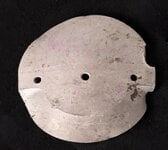EKimbrough
Recruit
- 3
- Jan 13, 2025
This part was recovered from the crash site of a P-51B Mustang on a glacier high on Mt. Zuckerhütl, on the Austrian / Italian border. The aircraft was struck by 20mm anti-aircraft rounds while strafing trains at Freising, Germany. The pilot, my uncle, bailed out when the engine failed over the Alps, and he became a POW. I have no idea what this part is, what its function is, or where it was located on the aircraft. Details:
There is a tiny part number stamped in the metal. It's either 39640 or 396401. (I can't tell whether the 1 is a digit or a small scratch in the metal.). I tried Google searches for P-51 plus the part numbers, but that led nowhere.
Aluminum
Circular - 5-1/2-inch diameter
Three 1/4-inch holes, collinear, unthreaded, spaced about 1-7/8 inches apart.
(Due to bending in the crash, and due to camera perspective distortion, the disc appears less circular in the photo than it really is, and the three holes don't appear to be in line, but actually are.)
Most interesting, the disc is flat in the center, but starting 1 inch in from the edge, the bottom half of the disc tapers from 1/4 inch thick to 1/16 inch thick. In the photo you can clearly see this slope and the steps that it creates on the left and right sides of the disc.
Stamped in tiny print on the disc, and barely visible in the photo under the part number, is 10°. I believe this refers to the angle of that taper.
The other side of the disc also has an identical taper, but it's on the top half, not the bottom half. 10° is also stamped in tiny print on the other side - the only marking there. Apparently, that 10-degree angle is important to whatever this thing does.
So, what is this, what did it do, and how did it do it?
Thanks!
There is a tiny part number stamped in the metal. It's either 39640 or 396401. (I can't tell whether the 1 is a digit or a small scratch in the metal.). I tried Google searches for P-51 plus the part numbers, but that led nowhere.
Aluminum
Circular - 5-1/2-inch diameter
Three 1/4-inch holes, collinear, unthreaded, spaced about 1-7/8 inches apart.
(Due to bending in the crash, and due to camera perspective distortion, the disc appears less circular in the photo than it really is, and the three holes don't appear to be in line, but actually are.)
Most interesting, the disc is flat in the center, but starting 1 inch in from the edge, the bottom half of the disc tapers from 1/4 inch thick to 1/16 inch thick. In the photo you can clearly see this slope and the steps that it creates on the left and right sides of the disc.
Stamped in tiny print on the disc, and barely visible in the photo under the part number, is 10°. I believe this refers to the angle of that taper.
The other side of the disc also has an identical taper, but it's on the top half, not the bottom half. 10° is also stamped in tiny print on the other side - the only marking there. Apparently, that 10-degree angle is important to whatever this thing does.
So, what is this, what did it do, and how did it do it?
Thanks!

